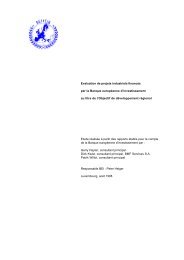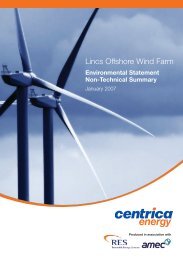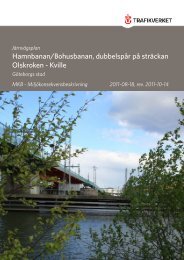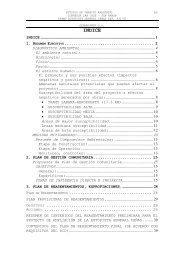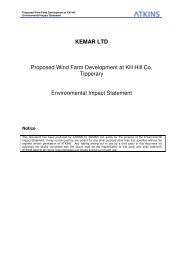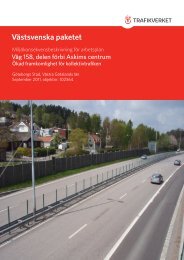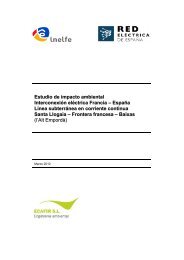event, a more conservative approach would have been preferable at least <strong>in</strong> <strong>the</strong> substantial number <strong>of</strong>repeat projects with a history <strong>of</strong> overestimates.Project implementation schedule. As mentioned before about two thirds <strong>of</strong> <strong>the</strong> projects evaluated hadimplementation delays, one third <strong>of</strong> which by three or more years. This suggests that <strong>the</strong> Bank shouldanalyze <strong>the</strong> potential causes <strong>of</strong> such delays more systematically and propose measures to m<strong>in</strong>imize<strong>the</strong>m where possible. Such an analysis could be a straightforward exercise, for <strong>in</strong>stance <strong>in</strong> <strong>the</strong> form <strong>of</strong>a checklist, because most potential causes <strong>of</strong> delay are known, i.e. lack <strong>of</strong> agreement withlocal/regional authorities on project details affect<strong>in</strong>g <strong>the</strong>m 23 ; <strong>in</strong>complete project designs andimplementation plans; political <strong>in</strong>terference <strong>in</strong> project implementation; natural causes such asgeological problems or archaeological f<strong>in</strong>ds. Although experience clearly shows that <strong>the</strong> Bank’s<strong>in</strong>fluence is limited without <strong>the</strong> promoter’s cooperation even when it has identified <strong>the</strong> problems, suchan analysis would at least result <strong>in</strong> a more realistic assessment <strong>of</strong> a project’s strengths and weaknesses.Economic analysis. All projects <strong>in</strong>cluded a quantified economic analysis, albeit <strong>in</strong> vary<strong>in</strong>g detail,completeness and quality. For example, <strong>in</strong> one appraisal <strong>the</strong> economic life <strong>of</strong> <strong>the</strong> project wasoverstated and <strong>in</strong> ano<strong>the</strong>r a different method (residual value) was used. In o<strong>the</strong>r projects, operat<strong>in</strong>gand ma<strong>in</strong>tenance costs were not taken <strong>in</strong>to account or <strong>the</strong> economic viability was based on <strong>the</strong> EIRRestimate <strong>of</strong> a much broader <strong>in</strong>vestment programme and not <strong>the</strong> project as such. O<strong>the</strong>r economicanalyses omitted <strong>the</strong> standard practice <strong>of</strong> sensitivity analysis as a gauge <strong>of</strong> <strong>the</strong> potential project risk.The end result was that only a few ex ante estimates <strong>of</strong> <strong>the</strong> economic viability <strong>of</strong> <strong>the</strong> projects evaluated<strong>in</strong> depth were methodologically entirely sound.Where possible, <strong>the</strong> ex post evaluation attempted to estimate <strong>the</strong> project EIRRs by us<strong>in</strong>g <strong>the</strong> standardmethodology but this could not always be achieved because <strong>the</strong> <strong>in</strong>formation was not available or notprovided for reasons <strong>of</strong> confidentiality (despite <strong>the</strong> Promoters’ contractual commitment to providesuch <strong>in</strong>formation). Obviously, <strong>the</strong> EIRRs calculated for projects that are delayed are subject to changeonce those projects have been completed and are operational. However, that does not alter <strong>the</strong>conclusion that <strong>the</strong>ir economic rates <strong>of</strong> return were much lower than estimated at appraisal because <strong>of</strong><strong>the</strong> substantial delays, cost <strong>in</strong>creases already <strong>in</strong>curred and lower demand, not to mention <strong>the</strong>occasional weaknesses sometimes <strong>in</strong> <strong>the</strong> appraisal methodology.Risk Analysis. The Bank’s analysis <strong>of</strong> <strong>the</strong> credit risks that it may <strong>in</strong>cur with a project has generallybeen satisfactory. As regards such o<strong>the</strong>r risks as traffic risk, implementation delays and cost <strong>in</strong>creases,<strong>the</strong> over-optimism <strong>of</strong> <strong>the</strong> appraisal teams has already been mentioned. In some appraisals <strong>the</strong>se riskswere taken <strong>in</strong>to account by means <strong>of</strong> a sensitivity analysis, <strong>in</strong> o<strong>the</strong>rs not. For example, <strong>the</strong> appraisal <strong>of</strong>a follow-on project had identified a high risk <strong>of</strong> cost <strong>in</strong>creases and delays as a result <strong>of</strong> <strong>the</strong> experiencewith <strong>the</strong> first project, but no sensitivity analysis was undertaken to quantify <strong>the</strong> impact <strong>of</strong> those factorson <strong>the</strong> project’s viability. In general, it can be said that even where sensitivity analyses wereperformed <strong>the</strong> worst-case hypo<strong>the</strong>sis usually proved too optimistic <strong>in</strong> <strong>the</strong> ex post evaluation.Apparently it is difficult to th<strong>in</strong>k <strong>the</strong> “unth<strong>in</strong>kable”, i.e. that a project might fail. An antidote could be<strong>the</strong> <strong>in</strong>clusion <strong>of</strong> a null hypo<strong>the</strong>sis <strong>in</strong> <strong>the</strong> sensitivity analysis, which would exam<strong>in</strong>e under whichconditions <strong>the</strong> proposed project would fail and give an estimate <strong>of</strong> <strong>the</strong> likelihood <strong>of</strong> such failure.Even when <strong>the</strong> risks were properly identified, mitigation measures were rarely recommended oraccepted by promoters. For <strong>in</strong>stance, <strong>in</strong> one (very large) project <strong>the</strong> promoter hired an expert at <strong>the</strong>Bank’s recommendation to monitor costs and project implementation, with <strong>the</strong> result that <strong>the</strong> Bankhad an excellent understand<strong>in</strong>g <strong>of</strong> <strong>the</strong> reasons for <strong>the</strong> delays and cost <strong>in</strong>creases but no <strong>in</strong>fluence on<strong>the</strong>ir mitigation. A fur<strong>the</strong>r Bank recommendation on how to deal with cost overruns and delays wasnot accepted by <strong>the</strong> promoter. A similar situation occurred <strong>in</strong> ano<strong>the</strong>r large project, where costoverruns and delays had already been experienced dur<strong>in</strong>g <strong>the</strong> <strong>in</strong>itial implementation stage. The Bankproposed assist<strong>in</strong>g <strong>the</strong> promoter with mitigation measures but this was rejected. The project has nowbeen delayed by three years. Of course, it is not possible to conclude whe<strong>the</strong>r acceptance <strong>of</strong> <strong>the</strong>23There was only one project that was on budget and on time where potential problems with local andregional authorities were discussed and cleared before project implementation started.21
Bank’s advice would have made any difference. The lesson that can be learned from this experience isthat <strong>the</strong> Bank has little leverage to <strong>in</strong>fluence <strong>the</strong> outcome <strong>of</strong> a project one way or <strong>the</strong> o<strong>the</strong>r, unless <strong>the</strong>promoter takes ownership <strong>of</strong> <strong>the</strong> Bank’s recommendations.6.5 F<strong>in</strong>anc<strong>in</strong>g arrangementsThe f<strong>in</strong>anc<strong>in</strong>g arrangements for 18 <strong>of</strong> <strong>the</strong> projects reviewed (<strong>in</strong> depth and desk reviews) consisted <strong>of</strong>direct loans to <strong>the</strong> Promoters. In 11 projects, f<strong>in</strong>anc<strong>in</strong>g was arranged via an <strong>in</strong>termediary, most <strong>of</strong>ten aGovernment agency or a special purpose vehicle created for <strong>the</strong> operation, and <strong>in</strong> one case morecomplex arrangements <strong>in</strong> <strong>the</strong> form <strong>of</strong> public private partnerships were chosen. In one <strong>of</strong> <strong>the</strong>se cases aspecialist was called <strong>in</strong> (at <strong>the</strong> expense <strong>of</strong> <strong>the</strong> Promoter) to assist with <strong>the</strong> design <strong>of</strong> <strong>the</strong> f<strong>in</strong>ancial<strong>in</strong>strument.6.6 Monitor<strong>in</strong>gThe Bank’s appraisal team normally recommends <strong>the</strong> type <strong>of</strong> project monitor<strong>in</strong>g that it deemsappropriate <strong>in</strong> <strong>the</strong> context <strong>of</strong> <strong>the</strong> complexity and potential risks <strong>of</strong> <strong>the</strong> project concerned and <strong>in</strong> <strong>the</strong>light <strong>of</strong> its knowledge <strong>of</strong> <strong>the</strong> borrower’s implementation arrangements and technical competence.Accord<strong>in</strong>gly, monitor<strong>in</strong>g categories 1 to 3 were assigned, with <strong>in</strong>creas<strong>in</strong>g degrees <strong>of</strong> monitor<strong>in</strong>g. Asregards <strong>the</strong> projects evaluated <strong>in</strong> depth and via desk studies <strong>the</strong> follow<strong>in</strong>g monitor<strong>in</strong>g categories wereassigned: category 1, five projects; category 2, twelve projects; category 3, ten projects. Six projectswere without a monitor<strong>in</strong>g category.The actual monitor<strong>in</strong>g was carried out <strong>in</strong> <strong>the</strong> majority <strong>of</strong> projects less <strong>in</strong> accordance with <strong>the</strong> assignedcategory than <strong>in</strong> accordance with <strong>the</strong> actual difficulties encountered. This has <strong>the</strong> benefit <strong>of</strong> utiliz<strong>in</strong>g<strong>the</strong> Bank’s scarce staff resources <strong>in</strong> an appropriate way. Thus, projects whose implementation wassmooth were not monitored at all. On <strong>the</strong> o<strong>the</strong>r hand, problem projects were monitored <strong>in</strong>tensely,<strong>in</strong>clud<strong>in</strong>g <strong>in</strong> one case <strong>the</strong> utilization <strong>of</strong> a specialist. In o<strong>the</strong>r projects, <strong>in</strong>tense monitor<strong>in</strong>g was a byproduct<strong>of</strong> follow-on operations by <strong>the</strong> Bank.However, <strong>the</strong> ultimate objectives <strong>of</strong> <strong>the</strong> monitor<strong>in</strong>g exercises were not clear. Thus, even <strong>in</strong> <strong>the</strong> caseswhere <strong>the</strong> Bank’s monitor<strong>in</strong>g identified serious issues, <strong>the</strong>re was no concrete action on <strong>the</strong> part <strong>of</strong> <strong>the</strong>Bank to mitigate or elim<strong>in</strong>ate those issues, unless <strong>the</strong> Bank’s loans were at risk directly. Thishappened, for <strong>in</strong>stance, <strong>in</strong> one project, when <strong>the</strong> guarantees for <strong>the</strong> Bank’s loans became worthless andnew guarantee structures had to be set up. It can <strong>the</strong>refore only be concluded that monitor<strong>in</strong>g was aresource-driven process, with as its ma<strong>in</strong> purpose at best to keep <strong>the</strong> Bank <strong>in</strong>formed <strong>of</strong> a project’sdifficulties, and that <strong>the</strong> Bank does not enter <strong>in</strong>to negotiation as long as its own loans are not at risk.On average, less than 3 progress reports were produced for each <strong>of</strong> <strong>the</strong> 29 projects evaluated.Never<strong>the</strong>less, important modifications <strong>in</strong> certa<strong>in</strong> projects were discovered too late. For <strong>in</strong>stance, oneproject was expanded geographically by 50% and <strong>the</strong> equipment to be procured also changedsubstantively. In ano<strong>the</strong>r project, only 340 project components out <strong>of</strong> <strong>the</strong> orig<strong>in</strong>al 820 were f<strong>in</strong>anced,while 389 new components were added. These changes should at least have warranted a reappraisal <strong>of</strong><strong>the</strong> Bank’s <strong>in</strong>volvement, <strong>in</strong> order to ensure that <strong>the</strong> project was still viable and its objectives were stillvalid (aga<strong>in</strong> <strong>the</strong>se two projects are very large projects). Also <strong>the</strong> direct impact on <strong>the</strong> Bank’s accountsis low, <strong>the</strong> promotion <strong>of</strong> <strong>the</strong> Bank’s “expertise” is not compatible with those issues. Obviouslymonitor<strong>in</strong>g has to be improved, especially for large projects (i.e. more than EUR 2 bn, as a rule <strong>of</strong>thumb).Completion reports were produced for only five <strong>of</strong> <strong>the</strong> 29 projects evaluated, <strong>of</strong> which two projectswere considered good, two satisfactory and one poor.Two o<strong>the</strong>r projects were closed adm<strong>in</strong>istratively, i.e. without a completion report. Questionnaires fortwo o<strong>the</strong>r projects were sent to <strong>the</strong> Promoters but not answered nor was this followed up by <strong>the</strong> Bank.22










